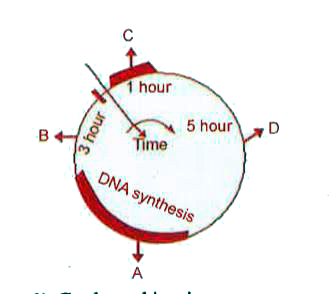In a dividing somatic cell, which one of the following stage is diploid ?
G1
G2
S
M
The correct Answer is:A
To determine which stage of a dividing somatic cell is diploid, we need to analyze the different stages of the cell cycle: G1, S, G2, and M phases.
1. Understanding Somatic Cells:
- Somatic cells are body cells that are not involved in reproduction. They are typically diploid (2n), meaning they contain two sets of chromosomes—one set from each parent.
2. Identifying the Stages of the Cell Cycle:
- The cell cycle consists of several stages:
- G1 Phase (Gap 1): The cell grows and carries out normal functions. At this stage, the cell is diploid (2n).
- S Phase (Synthesis): DNA replication occurs, resulting in the duplication of chromosomes. At the end of this phase, the cell has twice the amount of DNA, becoming tetraploid (4n).
- G2 Phase (Gap 2): The cell continues to grow and prepares for mitosis. The DNA is still in a duplicated state (tetraploid, 4n).
- M Phase (Mitosis): The cell divides into two daughter cells. Each daughter cell will have a diploid set of chromosomes (2n) after division.
3. Analyzing Each Option:
- Option A (G1): The cell is diploid (2n) at this stage.
- Option B (G2): The cell is tetraploid (4n) due to DNA replication.
- Option C (S Phase): The cell is also tetraploid (4n) as DNA is being replicated.
- Option D (M Phase): While the daughter cells will be diploid after division, during the actual process of mitosis, the cell is still in a tetraploid state until division is complete.
4. Conclusion:
- The only stage where the dividing somatic cell is diploid is the G1 phase. Therefore, the correct answer is Option A (G1).
Final Answer:
The diploid stage in a dividing somatic cell is G1 phase (Option A).
---
- Somatic cells are body cells that are not involved in reproduction. They are typically diploid (2n), meaning they contain two sets of chromosomes—one set from each parent.
- The cell cycle consists of several stages:
- G1 Phase (Gap 1): The cell grows and carries out normal functions. At this stage, the cell is diploid (2n).
- S Phase (Synthesis): DNA replication occurs, resulting in the duplication of chromosomes. At the end of this phase, the cell has twice the amount of DNA, becoming tetraploid (4n).
- G2 Phase (Gap 2): The cell continues to grow and prepares for mitosis. The DNA is still in a duplicated state (tetraploid, 4n).
- M Phase (Mitosis): The cell divides into two daughter cells. Each daughter cell will have a diploid set of chromosomes (2n) after division.
- Option A (G1): The cell is diploid (2n) at this stage.
- Option B (G2): The cell is tetraploid (4n) due to DNA replication.
- Option C (S Phase): The cell is also tetraploid (4n) as DNA is being replicated.
- Option D (M Phase): While the daughter cells will be diploid after division, during the actual process of mitosis, the cell is still in a tetraploid state until division is complete.
- The only stage where the dividing somatic cell is diploid is the G1 phase. Therefore, the correct answer is Option A (G1).
The diploid stage in a dividing somatic cell is G1 phase (Option A).
Topper's Solved these Questions
Similar Questions
Which of the following is diploid ?
View SolutionWhich one of the following is not a diploid cell ?
View SolutionWhich of the following is diploid?
View SolutionWhich of the following cell does not divide ?
View SolutionWhich one is diploid
View SolutionWhich of the following represents a diploid structure ?
View SolutionWhich of the following represents a diploid structure ?
View SolutionIn the somatic cell cycle.
View SolutionIn the somatic cell cycle.
View SolutionGiven below is a schematic break up of the phases/stages of cell cycle which one of the following is the correct indication of the stage/phase in the cell cycle
 View Solution
View Solution

